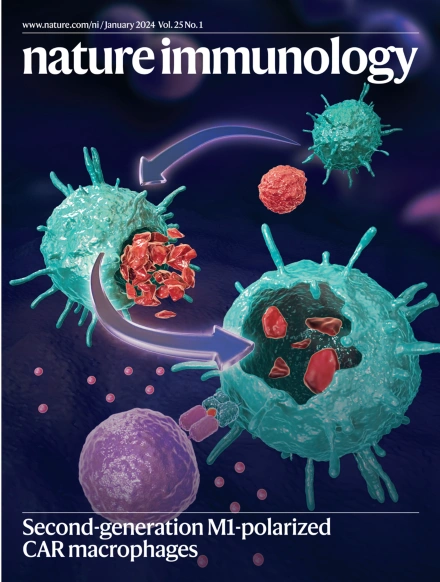羧化作用开关
IF 27.6
1区 医学
Q1 IMMUNOLOGY
引用次数: 0
摘要
线粒体膜上的线粒体抗病毒信号蛋白(MAVS)激活可介导干扰素(IFN)和细胞凋亡反应。在Science上,Okazaki等人表明MAVS的羧基化增强I型IFN反应并抑制细胞凋亡。MAVS在胞质域的Asp53、Glu70、Glu80和Asp83位点被羧化,并且γ-谷氨酰羧化酶(GGCX)的敲除减少了MAVS的羧化。GGCX是一种II型内质网(ER)跨膜蛋白,依赖于GGCX辅助因子维生素K使细胞外或内质网腔蛋白羧化。MAVS激活与内质网膜上非糖基化、倒置的GGCX蛋白积累增加有关。羧基突变体MAVS的表达、GGCX的缺失或维生素K的抑制降低了IFNβ,增加了caspase-3对病毒感染的反应。线粒体运输蛋白TOMM40和激酶PLK1与羧化突变型MAVS相关,而与野生型MAVS无关,caspase-3升高,但与IFNβ无关。在感染水疱性口炎病毒(VSV)的小鼠中,神经细胞中GGCX的缺失和维生素K的抑制或缺乏降低了I型IFN,增加了VSV滴度和caspase-3在野生型小鼠中的激活,而mavs缺陷小鼠则没有。因此,MAVS的GGCX羧化在病毒感染的细胞中起着调节开关的作用。原始参考文献:Science https://doi.org/10.1126/science.adk9967 (2025)本文章由计算机程序翻译,如有差异,请以英文原文为准。
Carboxylation switch
求助全文
通过发布文献求助,成功后即可免费获取论文全文。
去求助
来源期刊

Nature Immunology
医学-免疫学
CiteScore
40.00
自引率
2.30%
发文量
248
审稿时长
4-8 weeks
期刊介绍:
Nature Immunology is a monthly journal that publishes the highest quality research in all areas of immunology. The editorial decisions are made by a team of full-time professional editors. The journal prioritizes work that provides translational and/or fundamental insight into the workings of the immune system. It covers a wide range of topics including innate immunity and inflammation, development, immune receptors, signaling and apoptosis, antigen presentation, gene regulation and recombination, cellular and systemic immunity, vaccines, immune tolerance, autoimmunity, tumor immunology, and microbial immunopathology. In addition to publishing significant original research, Nature Immunology also includes comments, News and Views, research highlights, matters arising from readers, and reviews of the literature. The journal serves as a major conduit of top-quality information for the immunology community.
 求助内容:
求助内容: 应助结果提醒方式:
应助结果提醒方式:


